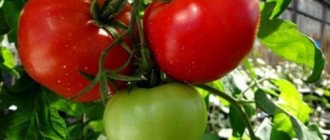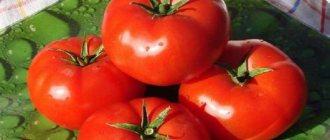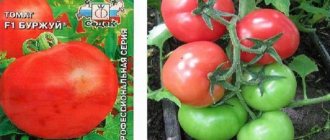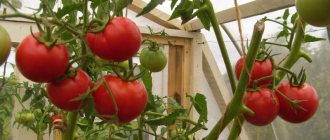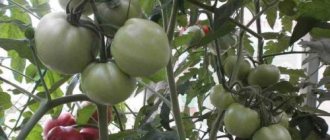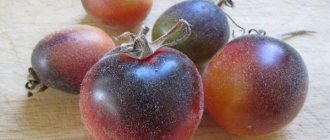Versatile tomatoes are always favorites in any tomato garden. Volgogradets is a productive variety of domestic selection, intended for cultivation in greenhouses; in the southern regions planting in open areas is acceptable.
| Height | Landing location | Ripening time | Fruit color | Fruit size | Origin | Fruit shape |
| Medium height | Greenhouse, Open ground | Mid-season | Reds | Average | Variety | Round |
Description and characteristics of the Volgogradets tomato variety, reviews, photos
Mid-season (105-115 days from germination to the beginning of ripening), determinate tomato variety for open ground.
The bush is semi-spreading, medium-branched, heavily leafy, up to 0.7 meters high. The leaf is light green, medium size, slightly corrugated. The inflorescence is simple. The first inflorescence is laid above the 8-9 leaf, the subsequent ones - every 1-2 leaves.
Fruit characteristics
The fruits are round, red in color at maturity, weighing 60-90 grams, fleshy, good taste. They have high transportability and good shelf life. These tomatoes are universal in purpose - suitable for both fresh consumption and all types of canning. The dry matter content in the juice is 4.2-5.3%, total sugar 2.8-3.7%.
Advantages of the variety : high yield, uniform ripening of fruits.
The Volgogradets tomato variety was included in the State Register in the Central Black Earth, North Caucasus, Lower Volga, Ural and Far Eastern regions in 1989 for one-time mechanized harvesting and rare harvests.
Originator of the variety: Volgograd Experimental Station VNIIR named after.
N.I. Vavilova RAAS.
Advantages of the variety
From the above data, it is concluded that “Volgogradsky” tomatoes are a determinant type. This is an unpretentious and easy-to-grow tomato with average resistance to known diseases that affect tomatoes. The first inflorescence forms above the sixth leaf.
The “Volgogradsky” variety is chosen by a large number of gardeners for a reason. All this thanks to the following advantages:
- easily tolerates adverse weather conditions and temperature fluctuations in open ground and greenhouses;
- the bush is not heavily covered with leaves, so the grown fruits are well warmed by the sun;
- the yield is always the same, regardless of the conditions during cultivation;
- excellent presentation and excellent taste;
- tolerates long-term storage and transportation;
- The harvest is used as desired: canned or fresh.
Features of cultivation, planting and care
Sowing the seeds of this variety of tomatoes for seedlings is carried out 60-65 days before the intended planting in the ground. Seedlings dive at the stage of appearance of the second true leaf. When planting seedlings in a permanent place per 1 sq. It is recommended to place up to 6 plants per meter of land.
Further care for tomatoes consists of timely watering, fertilizing, removing weeds, pinching (if necessary) and preventive measures to protect the crop from diseases and pests.
If you grew Volgogradets tomatoes, please write how they grew in your region. Were its fruits tasty? Why is it better or worse than other varieties for open ground? Briefly describe the advantages and disadvantages of this tomato in your opinion. If possible, attach to the comment a photo of the entire bush or individual ripe fruits that you grew. Thank you!
Your reviews of the Volgogradets tomato and additions to the description will help many gardeners evaluate this variety more objectively and decide whether it is worth planting or not.
Growing technology
You need to start preparing the beds in the fall. You need to dig up the soil and add humus, which is mixed with mineral complexes. It should last all winter. After the snow has melted, it is necessary to loosen the soil that has dried out in the beds and add ammonium nitrate.
The most successful seedlings are no more than seventeen centimeters high and have ten true leaves. You can plant seedlings only after the soil has warmed up well. The main thing is not to plant them ahead of time. If the spring cold returns, the plant will die.
In order for the seedlings to bear fruit, you need to monitor them. Water tomatoes only with warm water in the evening. Do not allow the soil to dry out or get too wet under any circumstances. This provokes the development of fungal diseases.
After watering the soil, it is recommended to loosen the soil, then air permeability will improve. Periodically make stepsoning, making a bush of one or two shoots.
You can feed tomatoes; two or three in one season will be enough. Use mineral fertilizers and organic tinctures made from mullein or bird droppings. Cleanliness is also important for good yields. Keep an eye out for weeds and remove them immediately if present. If desired, gardeners can spray the above-ground part of the plant with products that will protect against various diseases and the most common parasites.
Reviews about the Volgograd variety are only positive. After all, it is unpretentious and productive.
There are many varieties grown in the Volgograd region. Therefore, choosing for yourself not just one, even several, will not be difficult. Moreover, they all differ in shape, color and taste.
Description of the variety
Fruit:
- Slightly ribbed rounded shape;
- Red color;
- With dense, fleshy pulp;
- The number of seed chambers is from 2 to 3;
- Dry matter content from 4.2 to 5.3%;
- Small sizes. The average weight varies from 60 to 90 cm.
Description of tomato:
Bushes:
- Determinate, non-standard plant. Semi-spreading, with medium branching, and also abundantly leafy;
- Grows to approximately 70 cm;
- The leaves are medium-sized, light green in color, with a slightly corrugated surface;
- The inflorescence is simple. The first one is laid over 8-9 leaves, the next ones at intervals of 1-2 leaves.
Varieties of tomatoes "Volgograd"
“Volgogradsky” tomatoes include the following varieties: “Volgogradsky-323”, “Volgogradsky-5/95” and “Volgogradsky pink”. They are all tasty, beautiful and productive. But each representative has its own slight differences. Be sure to take them into account, first when choosing tomatoes, and then when growing them.
"Volgogradsky-323" is considered early, ripens within 110 days. The bushes are determinate, growing up to a maximum of forty centimeters. The fruits are round, smooth, with slight ribbing. The color of the tomatoes is red, weighing one hundred grams. The variety is productive and able to resist fusarium and verticillium.
"Volgogradsky-5/95" is able to keep up in 120 days. The plant is a standard plant; it can only grow a meter in height. The shape of the fruit is flat-round, slightly ribbed. The tomatoes are deep red in color and weigh up to 150 grams. You can easily transport the fruits.
Growing tomatoes
The tomato variety “Volgogradets” can be cultivated using both seedling and non-seedling methods. Traditionally grown through seedlings.
How to prepare seeds:
- First, it is worth disinfecting the seed material by placing it in a weak solution of potassium permanganate for 15-20 minutes. Then the seeds are washed and dried;
- Before sowing, soaking in a growth stimulator is necessary.
Sowing seed material:
- Seeds are sown for seedlings in mid-February;
- The planted seeds are placed in a warm place until the first shoots appear;
- With the emergence of seedlings, you need to lower the temperature and place the containers on a windowsill with sufficient lighting;
- After the formation of the first pair of true leaves, the seedlings are picked.
Rules for planting seedlings:
- Tomato bushes are transplanted into unprotected soil in April, into a greenhouse structure - in March;
- To grow tomatoes, it is advisable to use sandy soil, after carrots, cabbage, legumes or eggplant;
- Pre-planting soil treatment is carried out with boiling water to disinfect it;
- Planting holes are placed at intervals of 60-70 cm, observing the recommended density - no more than 5-6 seedlings per 1 m2.
Characteristics of tomato Volgogradsky 5/95 and agrotechnical cultivation rules
Tomato Volgogradsky 5/95, the description of which is associated with excellent taste characteristics and high yield, is popular among vegetable growers. The variety belongs to domestic selection, created by selection, zoned in 1953. The hybrid is still cultivated in household plots.
Benefits of tomato
Volgograd tomatoes combine several types, among which are Volgograd pink, Volgograd 323. Their characteristics have their own characteristics. The common parameter for the series is high yield and resistance to typical diseases of nightshade crops.
A medium-late ripening variety begins to bear fruit 115-130 days after germination. The tomato is intended for cultivation in open ground and greenhouse conditions. High yields are observed when grown in the southern regions.
Plants are determinate type, compact in shape, 70-100 cm high. Standard bushes with an average amount of light green foliage. They provide unhindered access of sunlight to the fruits. The trunk of the bush requires tying to a support.
The first brush is formed at the level of 5-6 leaves. The fruits of the Volgogradsky 595 variety are characterized by a flat round shape and slightly pronounced ribbing. When ripened, tomatoes acquire a shade of scarlet color.
The weight of tomatoes is 90-150 g. When grown in open ground, up to 3 kg of tomato can be removed from a bush. With a planting density of 3-4 plants per 1 m², the yield is 12 kg. The fruits contain 4.5% dry matter, 3% sugars. On a horizontal section, you can observe the presence of 5-6 chambers with seeds.
When cultivated in unprotected soil, the tomato variety Volgogradsky 5 95 adapts perfectly to temperature changes. Reviews from vegetable growers indicate that tomatoes retain yield and almost simultaneous fruit ripening, regardless of plant care.
The characteristics of the fruit indicate the possibility of storage and transportation over distances. In cooking, tomatoes are used for preparing salads, canning, pickling, and processing into sauce, paste, and juice.
Bush care
What care does tomato bushes need:
- Excessive watering should be avoided. In the absence of dry periods, watering is carried out once every two weeks. In case of prolonged drought, watering becomes more frequent, but without fanaticism. Otherwise, all the energy will go to the growth of green mass, which will negatively affect the number of fruits. The moisture level is quite easy to control: if the soil is moist at a depth of 10 cm, it does not need watering;
- If the number of ovaries is insufficient, the bushes are treated with urea or boric acid;
- It is recommended to feed the plantings with compost and rotted manure, which guarantees a bountiful harvest;
- One of the main advantages of the variety is the absence of the need for pinching. However, if this procedure is necessary, it is worth carrying out;
- It is advisable to carry out weeding at an early stage of growth, and loosening at a later stage. Don't forget about hilling. This activity is carried out several times until the plant begins to bear fruit;
- It is also necessary to carry out mandatory treatments using special means to prevent the possible occurrence of various diseases. In addition, with the help of timely treatment, the appearance of insect pests can be avoided.
Diseases and pests
The tomato variety “Volgogradets” is often susceptible to late blight, tobacco mosaic virus, blossom end rot and septoria.
Measures to prevent the occurrence and treatment of diseases:
- Late blight. The presence of dark spots that are located on leaves and fruits indicates a disease. If such signs are detected, it is necessary to remove the affected leaves as soon as possible and burn them. Uninfected fruits should be removed unripe, washed thoroughly and placed in water with a temperature of +60 degrees for 2-4 minutes. The following drugs are effective against late blight: Ecosil, Fitosporin, Bordeaux mixture, Tattu, Quadris, Ridomil Gold MC and whey;
- Signs of the tobacco mosaic virus are the appearance of yellow mottling on the foliage, which later turns into a green mosaic. At the same time, the leaves wrinkle and become deformed, and uneven ripening of small fruits occurs. For preventive purposes, it is necessary to treat seedlings and garden tools with a 5% manganese solution. If the first signs of disease are present on the plant, the bushes are treated with a 10% whey solution with the addition of microfertilizers. If a tomato crop grows in unprotected soil, it needs to be transplanted to another area, and the top soil layer is removed in a greenhouse structure;
- Blossom rot mainly affects unripe fruits, on the tops of which gray spots filled with liquid form. Subsequently, the spots turn brown, and the tomato peel dries out and cracks. The plant is treated by spraying with a solution of ash, calcium nitrate or the drug “Brexil Ca”;
- Symptoms of septoria include the presence of dark, wet spots that appear on the leaves. This leads to drying of the foliage, which inhibits the growth of the plant. The drugs Title, Tanus and Revos can cope with this disease;
- To protect against insect pests, tomato plantings are treated with insecticides as a preventive measure.
Tomato varieties for open ground, video
If you grew Volgograd early ripening tomatoes, please write whether you liked them or not. How did this variety perform in your climate? How do you rate tomato disease resistance? If possible, attach to the comment a photo of the entire bush as a whole or individual fruits that you grew. Thank you!
Your reviews of the Volgograd tomato and additions to the description will help many gardeners evaluate this variety objectively and decide whether it is worth planting or not.
Sources:
https://dachamechty.ru/tomat/luchshie-sorta-dlya-volgogradskoj-oblasti.html https://7ogorod.ru/pomidory/tomat-volgogradskij.html https://tomatland.ru/catalog/3797
Reviews about the variety from those who planted
The tomato variety “Volgogradets” is in demand among experienced vegetable growers not only due to its good balanced taste characteristics, but also because of the possibility of long-term storage of the harvest, as well as resistance to possible mechanical damage during transportation.
These positive characteristics make it possible to successfully grow tomatoes both for personal use and for sale. Despite the susceptibility of the Volgogradets tomato variety to some diseases, it is still loved by gardeners for its many positive characteristics. If you follow all the recommendations on agricultural technology, the reward will be a bountiful harvest of delicious tomatoes.
Review of the best tomato varieties for the Volgograd region
Every year the same question arises: what tomatoes should I plant?
This is considered a hot topic in the Volgograd region. Since the weather there is unstable and spring is cold. Many tomato varieties cannot withstand this climate. But, don't worry. There are two hundred types of tomatoes in the Volgograd region. These selections also include hybrids. The main thing for tomatoes is taste, original shape and attractive color. Early ripening is not the main indicator; it has been proven that tasty and healthy fruits appear by the end of summer.
Story
The tomato variety Volgogradsky 323 dates back to the 60s of the 20th century. It was created by scientists from the Volgograd Experimental Station of the Institute of Plant Growing named after N.I. Vavilova. The variety was included in the State Register of Breeding Achievements in 1973. The application for its registration was submitted in 1969.
Additional Information. Volgograd tomatoes 323 are not the only creation of scientists from this region. Earlier, thanks to Volgograd selection, the Volgogradsky 5/95 variety appeared (included in the register in 1953). He's late. A little later, gardeners learned about a mid-season variety called Volgogradets tomato. Its year of inclusion in the register is 1989.
What kind of variety is “Volgogradsky”
The best varieties of tomatoes for the Volgograd region include “Volgogradsky”. This variety is suitable for people who are just starting to grow tomatoes and are unsure of their abilities. This is due to the fact that it is unpretentious in care, and at the same time has a beautiful appearance, high yield and incredible taste characteristics. Not so long ago they began to grow it en masse, but few people know that the Volgogradsky variety has been around for many, many years. It was first discovered by domestic breeders in the seventies of the twentieth century. Every year more and more people are convinced that it simply cannot be found better than this variety.
Agricultural technology
Growing seedlings
It is recommended to sow seedlings 60-70 days before planting in a permanent place. The month of March is ideal. Depending on the climate, the summer resident himself decides when to do this business: at the beginning, middle or end of the month. In central Russia (for example, in the Moscow region), seedlings begin to be planted on the 20th of March. Thus, by mid-May the bushes will already be stronger. Due to the fact that the variety is early, the seeds can be planted in open ground or a greenhouse at the end of May. But the seedling method is the most preferable. At home, seeds have almost 100% germination.
The seeds are first soaked for several days in water or placed in damp gauze. Be sure to be treated with a manganese solution. The substrate for planting can be purchased at the store or formed independently. The main thing is that the soil mixture is free of pathogenic microbes and pests. To do this, it is fried in the oven and treated with boiling water. The variety grows better in soil where there is a sufficient amount of humus, sand and fly ash.
Characteristics and features of the variety
Frost resistance
Tomato Volgogradsky characteristics and description of the variety should begin with its frost resistance. The vegetable can be planted both in open and protected ground, but it does not tolerate spring frosts. The plant stops developing at +7…0 degrees. Summer cooling (up to +13…+17) does not frighten Volgograd growing in the open air. She can easily stand it. The same applies to heat.
Easily tolerates lack of rain and watering.
Cultivation of the crop takes place through seedlings that are grown at home. The variety can be planted with seeds in heated greenhouses (where at least +16 degrees) on high beds. Due to the fact that the variety is early, the seeds can be planted in open ground or a regular greenhouse at the end of May. The main thing is that the air temperature is not lower than +18…+22 degrees.
Productivity
Volgograd tomatoes 323 need 3.5 months to produce a harvest. This is an early variety. It takes about 100-108 days from full germination to the first ripe fruit. Approximately tomatoes can be served at the end of June, beginning of July. The variety is suitable for gardeners who do not want to wait long. According to reviews, the bushes do not bear fruit for a long time - about 15-25 days. In order to have fresh tomatoes before autumn, it is recommended to grow additional varieties of crops on the plot.
The yield is decent. The Volgograd tomato produces 5-7 kg of tomatoes per bush.
Bloom
The variety is early, so flowering occurs 20-25 days after planting in a permanent place or 80-85 after sowing seedlings. Lasts about 4-6 days.
The peculiarity of the variety is the huge number of yellow flowers. Flowering is going on smoothly. A peduncle is formed under almost every second leaf.
Pros and cons of the variety
Advantages
- Early variety. Summer residents can try tomatoes already at the end of June, beginning of July. The Volgograd pink tomato variety has a similar ripening period;
- The fruits are neat, even, compact, and of the same size. Average weight – 70 grams. Another variety of Volgograd selection, bred in 1989, has similar tomatoes - Volgogradets. The description of the Volgogradets tomato contains characteristics similar to Volgograd. For example, they are similar in terms of ripening, fruit color (scarlet color with an orange tint), determinate bushes, etc.;
- Tomato Volgogradsky 323, like Watercolor, Asvon, Parodist, does not need to be tied to a support or pinned. The plant is not tall - about 25-45 cm;
- Decent yield. 5-7 kg of tomatoes are removed from the bush. Another low-growing variety that has similar yields is Alaska;
- Excellent transportability. Like the varieties Diana F1, Kubanochka F1, Belfast, Volgograd tomatoes can be transported over long distances by placing them in boxes in several layers;
- Undemanding to watering. You need to water no more than once every 14 days. The varieties Gina and Kaspar F1 have similar characteristics;
- The fruits ripen together. In this, Volgogradsky is similar to the Raisin tomato;
- Resistant to common diseases: tobacco mosaic, fusarium, verticillium, brown spot. Volgogradets tomatoes and the Volzhsky variety have the same advantage.
Flaws
- Like the Dachnik variety, the Volgograd tomato bears fruit for a short time. Approximately all the fruits can be collected in a few weeks;
- Labor-intensive harvesting. Compact tomatoes are more difficult and take longer to harvest than large ones.
Volgograd early ripening tomato 323 is easy to grow. The variety is suitable for beginner gardeners. Caring for it is simple. It is recommended to water it infrequently; there is no need to tie it up or stake it. At the same time, tasty fruits will ripen in the first half of summer. Tomatoes are suitable for fresh consumption and storage for the winter.
Sources:
https://tomatland.ru/catalog/2193 https://web-selo.ru/sort-pomidora-volgogradets.html https://7ogorod.ru/pomidory/tomat-volgogradskij.html
The most popular varieties
Despite strong weather changes in the Volgograd region, tomatoes are still pleasing with their productivity. Such as Black Fig, Osiris, Aladdin's Lamp, Moscow Delicacy, Taimyr and the Volgograd variety is considered the star among all. But we'll talk about this variety later.
The Taimyr variety has unique tomatoes that are able to grow in the cold season. The fruits are small in shape, but sweet and strong. People jokingly call it "cherry". Due to the fact that the fruits grow in clusters.
Black Ethiopian is a prominent representative of “black” tomatoes. It is tasty and sweet, like all “black” tomatoes. But these are not all the unusual varieties that are grown in the Volgograd region. Chinese surprise, also called Green Sweet Tooth. The skin is green-yellow, the flesh is emerald green, tender. Aladdin's lamp resembles a pear and is bright orange in color; Spaghetti is similar to cucumber; The Lorraine beauty resembles a daisy when cut in half.
Yellow pepper - a specimen that looks like a pepper. It has few seeds and pulp inside, and the skin is dense. Therefore, it can be easily used for stuffing.
Breeders have proven that it is better not to grow early varieties in this area. There is no doubt that the plant will grow without being affected by diseases, but their harvest is small, and sometimes there is simply no harvest.
Recently, varieties of tomatoes have been developed that grow in the warm season; the fruits are sweet, medium in size and not affected by late blight. This disease often affects tomatoes and does not always lead to the death of the plant, but certainly to a decrease in yield. These include the Dream variety. It is hybrid and suitable for open ground. This is a late variety with good fruit set. They are fleshy, have few seeds, weighing an average of one hundred grams. The yield is good, at least three kilograms per bush.
This also includes the Yubileiny Ushakova variety. This is also a hybrid of two varieties - Cherry and Miracle of the Market. It is tall, climbing and best grown in greenhouses. Productivity is high, tomatoes ripen on the bush. Moreover, he is completely covered with them. The color of the tomatoes is bright red, but the size is small, about the size of a chicken yolk.
Tomatoes “Yubileiny Ushakova” are good, able to withstand cold and rainy weather, and do not succumb to late blight.
All of the above varieties of tomatoes are excellent for fresh consumption and for canning. They are also used for tomato juice, adjika and salads, which are sealed in jars. Varieties that have a small shape and bright color look interesting. You can create entire compositions in jars, as long as the hostess or owner has the imagination.
